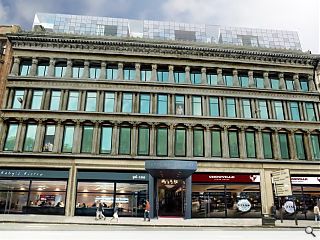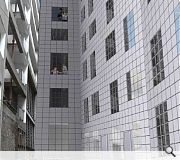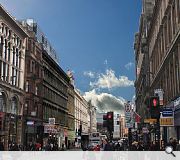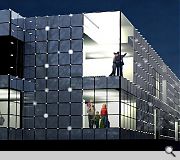‘Final’ Egyptian Halls application submitted
August 24 2012
A ‘final’ application for the redevelopment of Glasgow’s A-listed Egyptian Halls has been made by its owners to secure the long term commercial viability of the crumbling structure via conversion to a hotel.Prepared by the Morrison Partnership, who have been looking at the scheme since 2008, the plans call for the erection of a two-storey rooftop extension clad in a silver background grid, cladding which would also be applied to re-forming the rear external wall, which is in poor condition.
Richard Heggie, planning consultant for the scheme, said: "This proposal presents what may be a final opportunity to save the Egyptian Halls. We know that’s the outcome the building owners, the City Council, Historic Scotland, the Scottish Government and above all, the public would like to see.
“There’s no appetite for demolition - too many Greek Thomson buildings have been lost already. However, without public subsidy the project won’t stack up. We’ve aimed to minimise the cost to the public purse and have highlighted that reuse of the building will generate significant business rates for the Council.
“The wider benefits to the regeneration of Union Street are equally important. That’s effectively a condition of the Scottish Government’s approval of TIF funding for the Buchanan Quarter.
“The Egyptian Halls should be a flagship project - a statement of confidence in Glasgow's rebirth and Scotland's cultural heritage."
Developer Derek Souter hopes to obtain approval by December, he said: “In parallel with the relevant stakeholders USI are collaborating effectively with USP Ltd, which owns the ground floor and basements, and its current funder DBS-KPMG to bridge the funding deficit - primarily due to structural marketplace depression combined with 32 years of dereliction.”
|
|
15 Comments
#2 Posted by wonky on 24 Aug 2012 at 12:07 PM
Here, here. The whole fiasco should never have went on as long as it has- what of the Lion Chambers? Next in line?
#3 Posted by Rem Koolbag on 24 Aug 2012 at 12:07 PM
I am shocked at the exremely poor quality of visulisation for this scheme.
#4 Posted by kevin toner on 24 Aug 2012 at 14:33 PM
UR please choose your words more carefully: it's an alteration, not a redevelopment.
#5 Posted by ugh on 24 Aug 2012 at 15:01 PM
Looks pretty dire to me. Especially the alley (rear) elevation. if you're going to add to or modify such a prestigious building it could at least be done well...of course it is hard to tell from these images the exact quality of the scheme but these lacklustre visualisations hardly fill me with optimism.
#6 Posted by Dial-a-lama on 25 Aug 2012 at 20:06 PM
This might be the worst thing i have ever seen. I don't know what the history of the project is but the result appears awful - a very insensitive redevelopment (or alteration - just for you KT)
#7 Posted by Neil on 27 Aug 2012 at 10:58 AM
Strange. This seems to be part of a strategy, propose the most banal redevelopment of an important historic building, using the least talented architects. This proposal is only one of a number of frankly awful ideas from the owner, I recall . Demolition must be the prime objective therefor surely.
#8 Posted by Jimbob Tanktop on 27 Aug 2012 at 11:20 AM
Oh dear. This building offers a chance to reinvigorate the whole of Union Street.
With every successive proposal, it just gets more miserable and more banal.
Perhaps if the owner thought for a second about how long and disappointing his journey with this building has been, he might reconsider. Incrementally ticking boxes is grim. Taking a great asset and proposing something innovative shouldn't be this hard. Also, the endless bitching about why the taxpayer should shell out is wearisome. If they can't manage it, sell it to someone who can.
With every successive proposal, it just gets more miserable and more banal.
Perhaps if the owner thought for a second about how long and disappointing his journey with this building has been, he might reconsider. Incrementally ticking boxes is grim. Taking a great asset and proposing something innovative shouldn't be this hard. Also, the endless bitching about why the taxpayer should shell out is wearisome. If they can't manage it, sell it to someone who can.
#9 Posted by dirige on 27 Aug 2012 at 12:02 PM
Based on the images and the render of Union Street which is edited to make it look more cluttered than it already is, you would think they were wanting it to be refused planning..
#10 Posted by Art Vandelay on 27 Aug 2012 at 12:54 PM
I like the way the sky has been photoshopped in the street image - nice touch. As if having a blue sky somehow lifts the absolutely dire quality of the proposal - it's horrific.
Every comment I make seems to be about lost opportunities these days - pretty depressing stuff all round really. Although if it does end up being demolished, you can bet on an even worse new-build proposal for the resulting gap site.
Every comment I make seems to be about lost opportunities these days - pretty depressing stuff all round really. Although if it does end up being demolished, you can bet on an even worse new-build proposal for the resulting gap site.
#11 Posted by kevin toner on 27 Aug 2012 at 19:24 PM
#7, it’s not a redevelopment, nor an extension: it’s a partial conversion and alteration despite looking redeveloped from the rear.
-
Scalping and skinning the back of this building as planned may not be the end of the world if the promise of reversibility is genuine.
The rear stonework, window and skylight apertures etc. could be reinstated provided there is sufficient documenting and/or salvaging during the downtakings. I fear that having the existing elevations and roof plan alone will not suffice, i.e. without supplementary drawings, which will detail every square inch of what’s being removed.
I’m sure that the roof and rear elevations can ergo be ‘restored’ with therefore mainly newer material, i.e. should such restoration ever take precedence over the intervention at any future point.
It seems more about preservation in principle rather than restoration as yet!
-
Scalping and skinning the back of this building as planned may not be the end of the world if the promise of reversibility is genuine.
The rear stonework, window and skylight apertures etc. could be reinstated provided there is sufficient documenting and/or salvaging during the downtakings. I fear that having the existing elevations and roof plan alone will not suffice, i.e. without supplementary drawings, which will detail every square inch of what’s being removed.
I’m sure that the roof and rear elevations can ergo be ‘restored’ with therefore mainly newer material, i.e. should such restoration ever take precedence over the intervention at any future point.
It seems more about preservation in principle rather than restoration as yet!
#12 Posted by You say Potato on 28 Aug 2012 at 10:37 AM
Looks like a redevelopment to me and certainly not a partial conversion, nor an alteration.
#13 Posted by David Graham on 29 Aug 2012 at 14:49 PM
I must say that I agree with most comments on this proposal, the rear elevation and rooftop extension look dreadful.
However I feel as though it is a price worth paying if it ensures the long term future of this building, perhaps in years to come said rooftop extension and rear elevation could be reclad or reconstructed when more funds are available. At this stage any proposal that does not interfere too much with the integrity of the original Thomson building should be embraced, lets just hope that the rooftop extension is not visible from too many sightlines.
However I feel as though it is a price worth paying if it ensures the long term future of this building, perhaps in years to come said rooftop extension and rear elevation could be reclad or reconstructed when more funds are available. At this stage any proposal that does not interfere too much with the integrity of the original Thomson building should be embraced, lets just hope that the rooftop extension is not visible from too many sightlines.
#14 Posted by Egbert on 4 Sep 2012 at 11:45 AM
Abysmal visualisations and a sub-1987-Richard-Meier elevational treatment - my guess is the owner's heart isn't in this one. Time to sell up to someone who cares.
#15 Posted by kevin toner on 25 Jan 2013 at 11:39 AM
#12, Further to my past and future comments, free gratis educational points, on the wordplay or misuse/misconception of "redevelop", firstly pointed out to UR here at:
http://www.urbanrealm.com/news/3177/National_Museum_of_Scotland_refresh_spotlighted.html
“...Has misuse proliferated in recent times because of 1) the notion that everything a developer does is ‘development’; or 2) ...”
When it is architects that are convinced that a developer “redevelops” a conversion, refurbs, etc. and willy nilly speaks this lingo freely, then they've failed not merely to represent themselves as a genuine professional, but their colleagues, students, etc.: meaning - and eventually leading to - the proliferation of a misuse in the media that we can do without. Architects will understand why, if they explore conservation principles a little deeper in their syllabus, or simply recall a little more C20th literature, architectural or otherwise.
An architect doesn't “architect” change of use applications, really right, although venturing readily in them; nor would a sole baker bake bakery deliveries. It has been most likely architects stating whatever developer is “redeveloping/developing” whatever refurbs/alteration/etc. that has been undoubtedly to blame as the general public takes heed or listens to architects most on urban realm matters: I've little knowledge of developer and construction forums using the word wrongly.
So guys/gals (if you’re fortunate enough to have the riba/rias insignia and quallie letters after your surnames, then please do mind misusing the word: in fact try when you can to reinstate its real meaning to help restore real laypersons’ and media understanding.
My last comments on media [actually emanating from city council planning application misuse] was made here on UR:
http://www.urbanrealm.com/news/3920/%E2%80%98Shovel_ready%E2%80%99_Egyptian_Halls_redevelopment_wins_planning.html
at comments #5 & #9.
I’ll maybe do a wee compendium of all my comments on it and share them as free CPD in return for a part 3 placement or any architectural post for that matter anywhere before I clock more years of extra-curricular development than practice/studies. 13.5 years of solely “e-cd” to do before that will ever occur!
http://www.urbanrealm.com/news/3177/National_Museum_of_Scotland_refresh_spotlighted.html
“...Has misuse proliferated in recent times because of 1) the notion that everything a developer does is ‘development’; or 2) ...”
When it is architects that are convinced that a developer “redevelops” a conversion, refurbs, etc. and willy nilly speaks this lingo freely, then they've failed not merely to represent themselves as a genuine professional, but their colleagues, students, etc.: meaning - and eventually leading to - the proliferation of a misuse in the media that we can do without. Architects will understand why, if they explore conservation principles a little deeper in their syllabus, or simply recall a little more C20th literature, architectural or otherwise.
An architect doesn't “architect” change of use applications, really right, although venturing readily in them; nor would a sole baker bake bakery deliveries. It has been most likely architects stating whatever developer is “redeveloping/developing” whatever refurbs/alteration/etc. that has been undoubtedly to blame as the general public takes heed or listens to architects most on urban realm matters: I've little knowledge of developer and construction forums using the word wrongly.
So guys/gals (if you’re fortunate enough to have the riba/rias insignia and quallie letters after your surnames, then please do mind misusing the word: in fact try when you can to reinstate its real meaning to help restore real laypersons’ and media understanding.
My last comments on media [actually emanating from city council planning application misuse] was made here on UR:
http://www.urbanrealm.com/news/3920/%E2%80%98Shovel_ready%E2%80%99_Egyptian_Halls_redevelopment_wins_planning.html
at comments #5 & #9.
I’ll maybe do a wee compendium of all my comments on it and share them as free CPD in return for a part 3 placement or any architectural post for that matter anywhere before I clock more years of extra-curricular development than practice/studies. 13.5 years of solely “e-cd” to do before that will ever occur!
Post your comments
Read previous: MacTaggart & Mickel probe Eaglesham explosion
Back to August 2012
Like us on Facebook
Become a fan and share
News Archive
Search News
Features & Reports
For more information from the industry visit our Features & Reports section.







http://www.linkedin.com/pub/edward-harkins/15/40/635